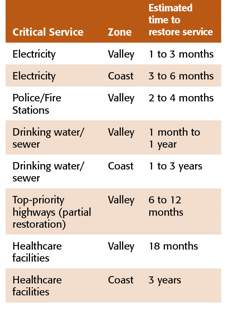Socio-Economic Resilience is Key to Recovery After a Disaster Strikes
 No one likes to think that he or she will ever experience a catastrophic event — a natural or manmade disaster that puts lives and communities at risk. Yet we’ve seen it happen again and again — Superstorm Sandy, Hurricane Katrina, the tsunami in Japan, the earthquake in Haiti. Closer to home, we’ve had forest fires in Southern and Central Oregon, train derailments in Eastern Oregon, flooding at the coast and, decades ago, an explosion in Roseburg when a truck loaded with fertilizer and dynamite caught fire.
No one likes to think that he or she will ever experience a catastrophic event — a natural or manmade disaster that puts lives and communities at risk. Yet we’ve seen it happen again and again — Superstorm Sandy, Hurricane Katrina, the tsunami in Japan, the earthquake in Haiti. Closer to home, we’ve had forest fires in Southern and Central Oregon, train derailments in Eastern Oregon, flooding at the coast and, decades ago, an explosion in Roseburg when a truck loaded with fertilizer and dynamite caught fire.
The reality is that catastrophic events can happen anywhere, at any time. When we talk about a regional disaster in the Northwest, the first thing that comes to mind is a major earthquake. It’s not just a distant possibility. Scientists warn that the next rupture of the Cascadia Subduction Zone, located just off the Pacific coast, may happen in the next 50 years. And it could be devastating — a 9.0 earthquake and resulting tsunami would wreak devastation from the coast to the Cascades.
We don’t know how or when disaster will strike, but we do know that we need to start getting ready now. The Ford Family Foundation is joining this effort as it embarks on a project to explore socio-economic resilience in rural communities in Oregon and Northern California.
Socio-economic issues — social and financial realities that make up quality of life — are deeply affected by disasters of all kinds. If we are to have healthy communities, we also must have the ability to deal with disasters if they strike. We call that ability “resilience,” and it’s all about making people, communities and systems better prepared to withstand catastrophic events of all kinds. It’s about being able to bounce back more quickly — sometimes even stronger.
This issue of Community Vitality explores a host of issues relating to community resilience. We look at what Oregon is doing to prepare for a potential earthquake and an article on what neighborhoods are doing to build resilience. We also talk with a Ford Opportunity Scholar about her work in Haiti, and to a high school student about her efforts to set up a teen Community Emergency Response Team in her town.
Particularly vulnerable
These kinds of efforts are of vital importance. Although rural communities are used to depending on themselves to some extent, they are particularly vulnerable to large-scale disasters because of fewer resources and access to help during the recovery process.
Communities are perhaps the most important element in a successful recovery from disaster. A survey from the Oregon Partnership for Disaster Resilience (OPDR) found that Oregon residents have more confidence in local efforts to support resilience than national or state-level efforts. This perception seems to be borne out in the wake of actual disasters. In the aftermath of Superstorm Sandy, for example, 31% of the people affected reached out to nearby friends, family and neighbors for help, according to a recent poll from the AP and the University of Chicago. Only 17% reached out to government programs.
Economic development and physical infrastructure, of course, play a big role in recovery efforts, according to the same report. But interestingly, recovery rates after Superstorm Sandy often differed in adjacent neighborhoods — even though they had similar economic and structural resources. The difference? Social resources. Community bonds. Trust. This connectedness could be drawn on, resulting in a faster recovery.
But still, economic resilience is crucial; Oregon respondents to the disaster resilience survey ranked medical services, utilities, and grocery/drug stores as critically important both before and after a catastrophic event. They also expressed concern regarding current conditions of those services. If economic resilience is already at risk, the aftermath of a catastrophic event becomes even more dire.
Earthquake. Fire. Chemical spill. Train derailment. It is up to us to plan for these events now, so our communities will be in a better position to deal with them should they happen. It’s time for us to start figuring out what we can do to prepare. By building resilience, we can prevent disasters from becoming community catastrophes.
Article reprinted with permission; Community Vitality Publication, Spring 2014, © 2014 The Ford Family Foundation. For the full Community Vitality edition of ”The Time to Prepare”, visit http://www.community-vitality.org/Spring2014TimeToPrepare.html
About the Author: David Frohnmayer was president of the University of Oregon from 1994 to 2009. He served as Oregon’s attorney general from 1981 to 1991. He is a former member of The Ford Family Foundation board of directors.

